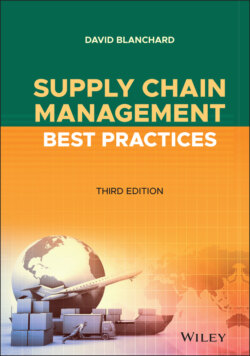Читать книгу Supply Chain Management Best Practices - David Blanchard - Страница 12
You Knew This Job Was Dangerous When You Took It
ОглавлениеImagine, if you will, a typical day in the life of a supply chain professional. Your boss comes into your office with one of those looks you've come to dread—furrowed brow, deep-set eyes, concerned scowl. He looks you straight in the eye and asks you why it costs so much to transport your company's products to your customers. You can tell by the expression on his face that he doesn't want to hear about fuel costs or industry consolidation or next-day delivery expectations from your customers. It's your job to worry about that stuff, not his. And right now, even though your budget projections say you'll have to spend at least 5% more on transportation this year than you did last year, your boss tells you in no uncertain terms that he expects you to keep the increase down to 2%, or less. Preferably less.
As you stand waiting for the Keurig machine to brew your much-needed second cup of coffee for the morning, your director of sales approaches you with a sheepish smile and asks if you can arrange for an extra thousand widgets to be made and shipped to a big customer by the end of next week. Actually, she doesn't really ask you so much as tell you, since she's already promised the customer that it will happen. She leaves before you get the chance to ask if she's charging the customer double the normal price since it'll cost you at least twice the normal rates to source the parts used to make the widgets from your offshore supplier, plus the cost of expedited delivery. On top of that, production will have to schedule an extra shift to get that many widgets made that quickly.
Later in the morning, while you're patting yourself on the back because you managed to find a domestic source for most of the widget parts, your boss asks you to shepherd your company's Internet of Things (IoT) initiative. The Department of Defense (DoD), another big customer, has started using IoT technology to keep better track of its inventory. Your boss wants you to figure out how IoT is going to help your company and result in more business from the DoD. Your boss waves off the list of questions that immediately come to your mind; he wants you to answer those questions yourself, provide him with regular updates on your progress, and map out an implementation plan that results in a decent return on investment within a year—no easy accomplishment given that the start-up costs on sensors and other hardware alone could quickly add up to $1 million for a limited trial.
For all his many faults, though, your boss is a fair man, and recognizing the extra burdens he's been laying on you, he invites you to lunch. Before your salad arrives, though, he's already launched into a harangue about automation. Your competitors have been getting to market faster and are spending less money to do it, and he's convinced it's because they've deployed automated guided vehicles in their warehouses. So when you get back to the office, he wants you to figure out which type of warehouse robot can manage your facility better, faster, and cheaper for you. Your customer service levels, needless to say, cannot change in the slightest, unless of course they actually improve. And make sure the union steward knows this technology investment won't lead to any layoffs.
Oh, and one more thing, your boss adds as you get up to leave the restaurant: He wants you to schedule another trip to Asia (your seventh trip there in three years). It's time, he says, to get serious about this corporate social responsibility stuff, and he wants you to oversee an audit of your offshore suppliers.
Most of your afternoon is spent trying to mend some fences down in the information technology (IT) department. Your chief information officer has made it clear that absolutely nobody is going home today until somebody can figure out why the supply chain planning system still isn't fully integrated with the inventory management system—and why manufacturing keeps making 12-inch widgets when the sales plan calls for 18-inch versions. Toward the end of the afternoon, your plant manager asks for “a little bit of help” calculating what the plant's carbon footprint is. You get the unmistakable feeling that he wouldn't mind one bit if you figured it out for him.
As you finally shut down your computer and get ready to call it a day, your head of human resources pops her head in your doorway and tells you she hasn't had a bit of luck yet finding a global trade expert, so it looks like you'll have to keep filling in for a while longer. Hearing the tail end of that conversation, your boss walks with you out to the parking lot and reminds you he still needs to see your contingency plan in the event an outbreak of a disease nobody even heard of a month ago spreads throughout the region where one of your key suppliers is located. Oh, and a big storm is developing in the Atlantic Ocean, and another one of your supplier's plants is right in the storm's path. Fortunately, you'll be able to monitor the situation from your home throughout the evening, thanks to the cloud-based supply chain alert dashboard app your company has purchased for you.
At the end of the day, after you've kissed your spouse goodnight and laid your head on your pillow, you drift off to sleep secure in the knowledge that the distance between you and your supply chain is no further than the smartphone 12 inches away from you on your nightstand.
